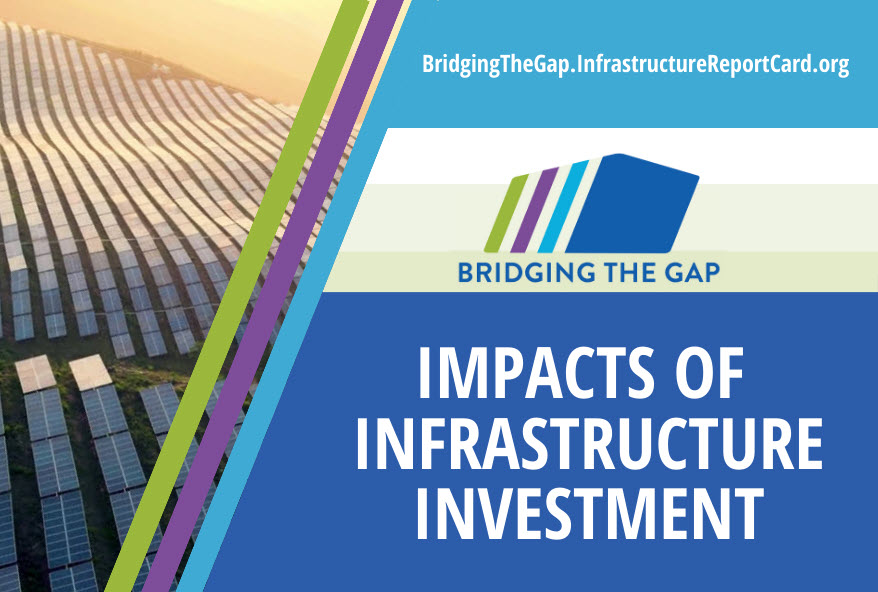
The Infrastructure Investment and Jobs Act – and its $1.2 trillion funding windfall – is saving the average American household nearly $700 a year, according to a new ASCE report.
Beware the snapback, though.
ASCE’s Bridging the Gap: Economic Impacts of Infrastructure Investment 2024-2043 report, released today, May 13, finds that while the IIJA investment has been essential to the country’s infrastructure, continued investment is necessary or those savings to each American household vanish by 2026.
The report analyzes two funding scenarios over the next 20 years:
- The Continue to Act scenario, in which the new IIJA funding levels represent a baseline for future funding levels
- The Snapback scenario, in which funding levels after 2026 return to pre-IIJA investments
The scenario that maintains current IIJA funding into the next decade would save the U.S. GDP $637 billion, according to the report.
“We failed to prioritize America’s infrastructure systems for decades, and those costs were passed down to businesses and consumers alike,” said ASCE President Marsia Geldert-Murphey. “Federal action has made substantial progress in stopping the growth of our needs, but this is just the beginning.
“We need continued action at the federal level and collaboration from state and local governments and the private sector if we are going to succeed in transforming our aging infrastructure network to be more sustainable, resilient, and best suit the future needs of American households and businesses.”
ASCE releases the Bridging the Gap report today at a launch event in Washington, D.C.
Darren Olson, chair of ASCE’s Committee on America’s Infrastructure, spoke to Civil Engineering Source about the new economic study and why he sees this push for continued infrastructure investment as being in some ways even more important than those ASCE advocacy efforts that resulted in the IIJA in the first place.
Civil Engineering Source: What do you say to folks who say, “Look, you got your IIJA money, aren’t you happy? Why are you still telling me there’s a gap here?” How do you approach that conversation?
Darren Olson: I think the way I approach it is that our investment has been delayed for so long. Our needs have continued to grow for decades, and only just recently, in the past few years with the IIJA and IRA [Inflation Reduction Act], have we seen a renewed investment in infrastructure.
But it’s a down payment. It’s the start of the process to slow the growth of the gap, but because we have not done this for so long, it is impossible to significantly impact the gap without a long-term sustained investment.
Source: As somebody who's leading a lot of those conversations and trying to make that argument, how important is it for you to back that logic with the real numbers and the real data in a report like this?
Olson: It’s so critical. Some of the figures in the report bring it down to the level of the American household. It says that if we continue to act, we will save the American household $700 annually in costs that would be associated with infrastructure failures.
So, they won't have to pay for replacing their groceries in the refrigerator that are ruined because the power goes out. They don't have to worry about buying bottled water because they’ve got a water-main break. This is money that is going into Americans’ pockets every year because we will be investing in infrastructure.
And that is such a powerful message when we’re talking to our elected officials because it shows them that this investment is having a direct benefit to their constituents. It’s a very powerful number to have.
Source: You've been doing this advocacy work for a while. Do you feel like this is an easier case to make than it was pre-IIJA when the message was ASCE’s Failure to Act reports? Or is it, in some ways, more challenging?
Olson: Yeah, it’s interesting. Part of it is a little bit easier because we can point to something positive in this report. We can say, “Here’s what we’ve seen. IIJA has been a benefit, and here’s how much more of a benefit it could be if we sustain this investment.”
I think that is an extremely positive message to come out of this, and it’s different than previously talking about Failure to Act. I mean, just the title of that is obviously not the most positive. But it was because we were as a country for so long literally failing to act.
So that key message with Bridging the Gap is positive. And to your original question, if I’m an elected official, I want to say, “We just did a yeoman’s lift here for infrastructure investment. We want to see that benefit.” This report does highlight that for them. And then it highlights even more just how much better off we can be if we continue to invest.
Source: Were there any surprises for you in the data or in some of the key takeaways from the report?
Olson: One thing that is always surprising is just how quickly the landscape of infrastructure changes.
With COVID and work-from-home, people’s expectations for transportation and surface transportation have changed to a surprising degree. And the other big change is in energy. I think about where we have come in energy in the last four years with renewables now making up a much larger percentage of our power generation. I think about our electric grid and transmission grid being on an absolutely critical path toward figuring out how we’re going to be able to utilize these renewable energy sources and with electric vehicles that have come in during the last four years.
It all just has me reflecting back on how quickly the landscape of infrastructure can change.
Source: And I guess that seems like all the more reason to focus on investment, right? The last thing you want to be doing is stretching and stretching and stretching to find money just to build something back to the expectations we had 10 years ago.
Olson: Yes, and I think it speaks to why we need more data to make those investments wisely, which is also part of what the Bridging the Gap report gets at.
I think you hit the nail on the head. The more data we have and the more ability we have to focus the investment given how quickly things change is a critical piece of this.
Register today for a Bridging the Gap webinar, 3 p.m. Eastern, May 22.
Read the entire Bridging the Gap report.



